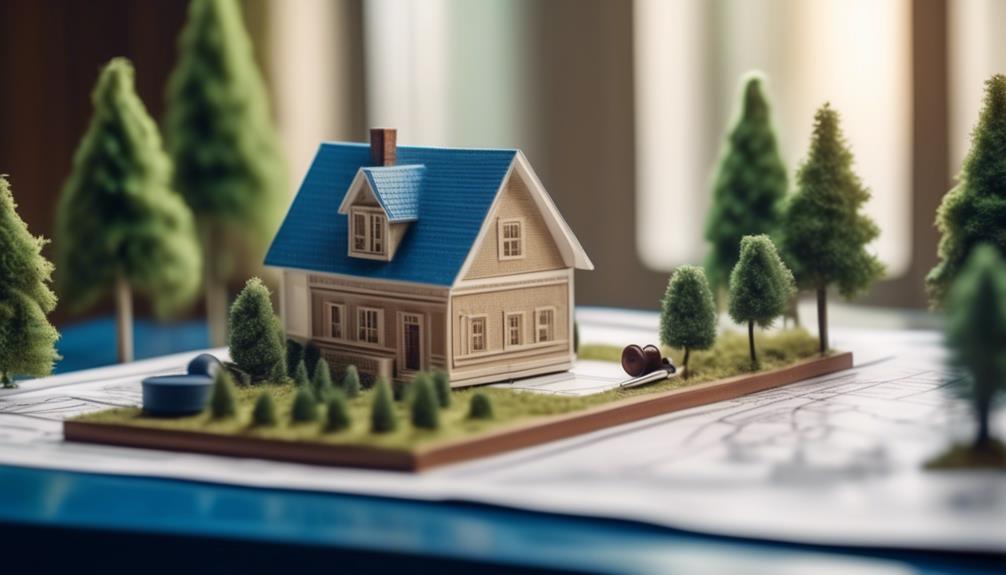Just as you've finally decided to embrace the simplicity of tiny living, you find yourself standing at the crossroads of zoning laws, a maze that seems almost designed to test your resolve.
You're not alone in this; many before you have navigated this labyrinth, and with the right approach, you'll find your path through as well.
Understanding the intricacies of zoning for your tiny home isn't just about following the rules—it's about knowing how to work within a system that wasn't originally designed with tiny homes in mind.
You'll need to arm yourself with knowledge of local ordinances, building codes, and perhaps even courtship of local officials to ensure your diminutive dwelling doesn't hit a legal snag.
As you stand ready to transform your tiny home dream into a reality, remember that the keys to unlocking this process lie within the specifics that tailor to your chosen location.
Let's gently unfold the map that will guide you through the necessary steps, anticipating the challenges you might face and the solutions that await just around the corner.
Key Takeaways
- Familiarize yourself with local zoning codes and land use ordinances to understand the regulations and requirements for building a tiny home.
- Target mixed-use, residential, or R-1 zones as suitable locations for your tiny home, ensuring compliance with zoning and building codes.
- Engage with local planning departments and officials for clarification and guidance on navigating residential zoning codes and applying for zoning variances.
- Demonstrate compliance with safety standards, structural integrity, and fire safety measures to optimize the chances of variance approval and ensure the legality and safety of your tiny home project.
Understanding Zoning Basics
Before you embark on building your tiny home, it's crucial to familiarize yourself with the local zoning codes that will dictate where and how you can construct your dwelling.
Researching local zoning laws is a pivotal step, ensuring your project's compliance with land use ordinances. Engage with local planning departments for a thorough understanding of zoning regulations specific to tiny homes. Verify that your intended location permits such communities and adheres to the zoning laws and building codes.
Be proactive in assessing utility connection availability, including water, electricity, and sewage. Additionally, draft a detailed set of community rules and agreements to circumvent potential legal hurdles.
Adhering to local regulations is non-negotiable for the innovative realization of your tiny home vision.
Identifying Appropriate Zones
As you identify appropriate zones for your tiny home, you must thoroughly understand the local zoning regulations that govern potential sites. You'll need to examine whether areas zoned for mixed-use, residential, or specifically R-1 can accommodate your tiny home, ensuring compliance with both zoning and building codes.
It's crucial to engage with local officials to clarify any specific requirements and navigate the intricacies of residential zoning codes for your project's success.
Understanding Zoning Regulations
To successfully establish a tiny home, you must first meticulously research local zoning codes to verify whether such dwellings are permissible in your desired location. Tiny House Zoning Laws vary, and you're tasked with understanding the local regulations that dictate if you can build a tiny house in specific areas.
Key considerations include:
- Zoning Regulations:
- Identify areas zoned for mixed-use, residential, or R-1 where tiny homes are often allowed.
- Engage with local officials to clarify restrictions.
- Compliance Requirements:
- Adhere to safety standards outlined in the International Residential Code (IRC).
- Ensure that accessory dwelling units (ADUs) meet specific building codes.
- Innovation Emphasis:
- Explore innovative zoning solutions that accommodate tiny homes, potentially influencing changes in allowed zones.
Suitable Locations for Tiny Homes
You'll need to target zones designated as mixed-use, residential, or R-1 to find suitable locations for your tiny home. Diligently research local zoning laws and consult with local officials to navigate housing regulations that align with your vision of sustainable living.
Ensure that the chosen zoning districts adhere to building codes applicable to tiny houses, especially concerning utility connections and setback requirements.
To avoid legal complications, verify that your preferred site complies with local zoning codes and housing regulations. Proactive engagement with authorities will clarify restrictions and opportunities within your desired zone, facilitating a smoother transition into your innovative housing solution.
Keep abreast of the evolving zoning regulations that impact suitable locations for tiny homes, guaranteeing your project's compliance and success.
Navigating Residential Zoning Codes
Before securing a location for your tiny home, it's essential to delve into the local zoning codes to identify zones where such dwellings are authorized. Understanding zoning regulations is crucial to avoid potential legal challenges.
As you research your local laws and building codes, focus on:
- Identifying Appropriate Zones:
- Mixed-use areas may offer flexible housing options.
- Residential or R-1 zones often accommodate single-family dwellings, including tiny homes.
- Some zones may specifically permit tiny houses on wheels.
Navigating the legalities with local governments can streamline your efforts to live in a tiny home. Engage with authorities to clarify minimum size requirements and ensure your tiny home meets all safety standards.
Always aim to align your innovative living solutions within the established regulatory framework.
Navigating Local Ordinances
Navigating local ordinances requires a meticulous review of zoning regulations to ensure your tiny home meets all legal and safety standards. Delve into the specifics of local ordinances, focusing on minimum standards for dwellings, including size and height restrictions that may impact tiny houses. Engaging with local officials is critical; they'll provide insights into navigating the process effectively.
Ensure compliance with building codes, prioritizing safety standards that govern construction and habitation. Collaborate with utility providers early on to secure access to utilities, avoiding legal issues down the line.
Applying for Zoning Variances

To navigate the complexities of zoning for your tiny home, you must first grasp the specifics of variance requirements.
You'll need to meticulously prepare your application package, ensuring it aligns with the stipulated guidelines of your local zoning ordinances.
Engage proactively with zoning authorities to clarify any uncertainties and to optimize your chances for a successful variance approval.
Understanding Variance Requirements
When planning your tiny home community, it's crucial to engage with local zoning authorities to understand the intricacies of applying for the necessary zoning variances. You'll need to:
- Familiarize yourself with variance requirements, which may include:
- Demonstrating hardship due to strict application of community zoning laws.
- Ensuring your proposal aligns with construction and safety standards.
- Proving the variance won't negatively impact the neighborhood character.
Investigate specific requirements that could influence your project, such as:
- Building codes tailored to compact living spaces.
- Tiny house regulations potentially affecting the sustainability of your housing solution.
Develop a strategy to avoid legal issues by:
- Collaborating with experts who are versed in the nuances of zoning for your tiny home.
- Adhering strictly to local ordinances to foster innovative, yet compliant, sustainable housing solutions.
Preparing Your Application Package
Before submitting your application for zoning variances, ensure that you have thoroughly reviewed the local zoning codes to confirm that your tiny home community complies with area-specific regulations. Your application package should meticulously document how your proposal aligns with existing legal frameworks and safety standards. Highlight the structural integrity and fire safety measures intrinsic to your construction plan.
Innovation in tiny house regulations necessitates a sophisticated approach, demonstrated below:
| Requirement | Your Compliance |
|---|---|
| Zoning Laws | Documented alignment with local codes |
| Building Codes | Meets or exceeds standards |
| Utility Connections | Coordination with service providers |
| Safety Regulations | Adherence to construction and safety protocols |
| Legal Considerations | Evidence of due diligence and legal conformity |
This table should serve as a checklist ensuring your tiny home is not only innovative but also regulation-ready.
Building Code Compliance
Ensure your tiny home aligns with local building codes to maintain high safety and construction standards. Building code compliance is critical as you innovate within the tiny houses sector. By collaborating with knowledgeable architects or contractors, you'll navigate the labyrinth of laws that govern:
- Structural integrity and safety
- Fire safety regulations
- Specific electrical standards
- Plumbing requirements
These codes not only ensure the structural integrity of your tiny home but also safeguard the community. Tiny homes may be unique in their square feet footprint, yet they must adhere to the same rigorous standards as larger dwellings.
It's imperative to familiarize yourself with the local codes to guarantee your tiny home's legality and safety.
Engaging With Tiny Home Communities

Engage with local zoning authorities to ascertain the specific requirements and limitations for establishing a tiny home community in your preferred area. When zoning for your tiny home, research is critical to avoid legal pitfalls.
A tiny house community provides a unique sense of community, fostering social interaction among like-minded individuals. To ensure the viability of your community, collaborate with local utility providers for necessary services, thus building a strong infrastructure foundation.
Develop clear community rules, focusing on the nuances of tiny house living. Addressing these details is essential for engaging with tiny home communities effectively.
Don't overlook the integration of Community Gardens, which enhance the communal experience. Rigorous planning and adherence to zoning regulations are the keystones for successfully navigating this innovative housing movement.
Frequently Asked Questions
What Are the Steps to Building a Tiny House?
You'll start with a design blueprint, emphasizing space optimization and custom features. Choose sustainable materials, a suitable foundation, and efficient utility connections. Consider loft designs for extra room and integrate innovative storage solutions throughout.
Do I Need a Permit to Build a Tiny House in My Backyard in Texas?
Yes, you'll need a permit for backyard construction in Texas, where regulations emphasize property boundaries and land use compliance. Check municipal codes and zoning for legal implications and to secure ownership rights.
What Is the Building Code for a Tiny House in California?
In California, tiny living must adhere to specific codes regarding size limits, foundation requirements, and utility connections. You'll navigate residential zones, ensure code compliance, meet design standards, and undergo the permitting process for legal placement.
Where Can You Put Tiny Homes in Texas?
In Texas, you're exploring rural options for urban living innovation, where city ordinances and Texas regulations on property zoning allow tiny homes. Ensure you check homeowner associations, utility connections, and community developments before leasing or purchasing land.
Conclusion
In conclusion, steering your diminutive dwelling to regulatory harmony necessitates meticulous attention to local edicts.
Ensure you're conversant with the labyrinthine tapestry of zoning intricacies and building statutes.
Cultivating rapport with municipal connoisseurs can illuminate the path to compliance.
Embrace the process with diligence, for the fruition of your tiny abode hinges on the meticulous orchestration of codes, variances, and communal synergy.
Your endeavor's success lies in the delicate balance of regulation and innovation.

